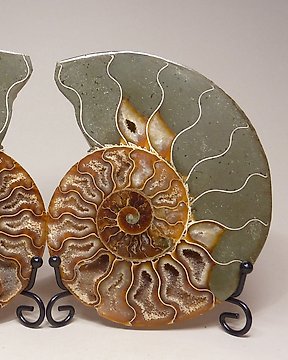
Ammonite - Animale fossilizzato - Aioloceras (Cleoniceras) sp. - 13.5 cm (Senza Prezzo di Riserva)
N. 83176339

N. 83176339

Facts about ammonites -
Closest living relative - Octopus, Squid, Cuttlefish and it's closest cousin the Nautilus.
First appeared - in shallow seas 450 million year ago.
Extinct - in a catoclysmic event in the Cretaceous, with the dinosaurs about 65 million years ago.
Began life - less than 1 mm in diameter. About the size of a period in this sentence. But they grew fast.
Females - reported to grow 400% bigger than males.
Shells - comprised of chambers growing as the ammonite did. Making 13 new chambers each year. The ammonite lived in the last section, called the living segment.
Medieval Europe - Ammonites were thought to be petrified snakes. They were called "snakestones" or "serpent stones". Ammonites were said to be evidence for the actions of St. Hilda and St. Patrick - who drove the snakes out of Ireland. In ancient times, traders would carve the face of a snake into the wide end of the ammonite fossil and sell them to the public.
The name Ammonite - comes from their spiral shape. The fossilized shells somewhat resembled tightly coiled rams' horns. Pliny the Elder (79 A.D. near Pompeii) called these fossils - ammonis cornua ("horns of Ammon") . Because the Egyptian god Amman was typically depicted wearing ram's horns.
Come fare acquisti su Catawiki
1. Scopri oggetti speciali
2. Fai l’offerta più alta
3. Paga in tutta sicurezza